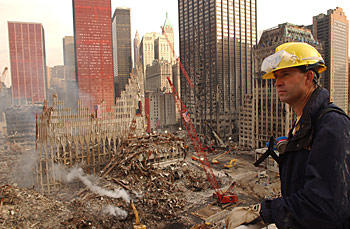
Worker looks over the disaster site at New York City's World Trade Center complex a few days after the Sept. 11, 2001, terrorist attacks.
For more than 40 years, scientists and engineers at the National Institute of Standards and Technology (NIST) have studied structural failures caused by natural disasters, fires and man-made factors, and used the lessons learned to improve building and fire codes, standards and practices. With the launch of the Disaster and Failure Studies Data Repository, NIST has begun to make this valuable information accessible more easily online.
The repository will ensure that data collected during and after a disaster or failure event, as well as data generated from related research, is organized and maintained to enable study, analysis and comparison with future severe disaster events. It also will serve as a national archival database where other organizations can store the research, findings and outcomes of their disaster and failure studies.
As the database grows, it will include data on significant hazard events; how buildings and other structures performed during those events; associated emergency response and evacuation procedures; and the technical, social and economic factors that affect pre-disaster mitigation activities and post-disaster response efforts.
The Disaster and Failure Studies Data Repository is being established in two phases:
Phase 1—which has just been completed—includes data from NIST's six-year investigation of the collapses of three buildings at New York City's World Trade Center (WTC 1, 2 and 7) as a result of the terrorist attacks on Sept. 11, 2001. Now available are thousands of photos and videos collected during the investigation; computer simulations created to model aircraft impact damage, fire spread and structural design characteristics; and the complete set of technical reports that document the body of NIST's work.
Phase 2 will include a larger collection of information on hazard events such as earthquakes, hurricanes, tornadoes, windstorms, community-scale fires in the wildland-urban interface, structural fires, storm surges, floods and tsunamis, and man-made hazards (accidental, criminal or terrorist).
By making this data available online, NIST hopes to support the development of standards and new technologies that enable more efficient collection of data on disaster and failure events.
NIST is providing these materials as a public service and to comply with regulations that require federal agencies to provide equal access to data available for public release. The materials in the new online repository serve as a historical archive. Some of these materials may contain offensive language or images/videos that some may find graphic. Some of the materials are protected by copyrights owned by private individuals or organizations, and subject to restrictions. Where possible, NIST has identified the copyright owner.
The Disaster and Failure Studies Data Repository is accessible online.

